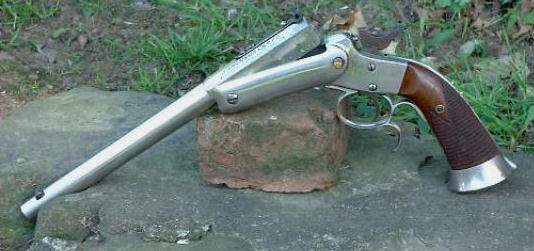

 The Accurate Reloading Forums
The Accurate Reloading Forums  THE ACCURATE RELOADING.COM FORUMS
THE ACCURATE RELOADING.COM FORUMS  Guns, Politics, Gunsmithing & Reloading
Guns, Politics, Gunsmithing & Reloading  Single Shot Pistols
Single Shot Pistols  7mm 120 grain TTSX recovered from a hog
7mm 120 grain TTSX recovered from a hogGo  | New  | Find  | Notify  | Tools  | Reply  |  |
| one of us |
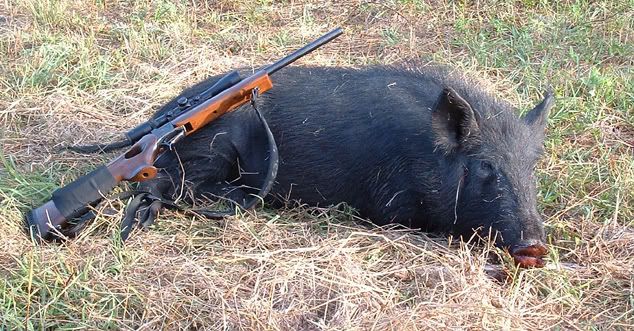  Well, a hog decided to provide a target opportunity for me this morning, and I used my 20" 7mm Bullberry Contender Carbine. The basic info is on the photo. I just wonder if the bullet would have expanded anywhere near as much had solid bone not been impacted. Also, while it obviously did the job, this is far from the full depth-of-cavity expansion Barnes continues to promote in its marketing. This bullet shoots extremely well in my 7mm Bullberry, and while it is a good product, I continue to contend that the TSX and TTSX are best suited for cartridges with the capacity of the '06 and up. But that's just my .02. As for me, I may pop another hog or two with the TTSX, but for deer hunting, I'll be returning to my tried-and-true Noslers in this caliber. Bobby Μολὼν λαβέ The most important thing in life is not what we do but how and why we do it. - Nana Mouskouri | ||
|
| one of us |
This photo will give better scale. 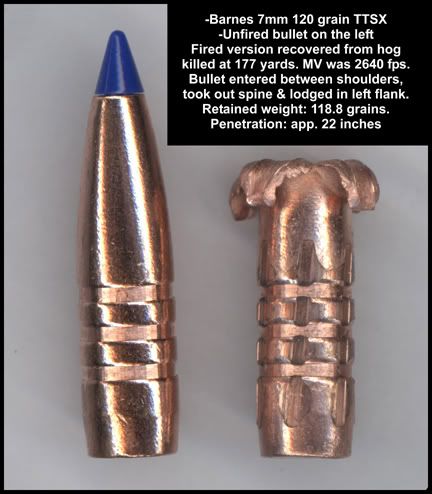 Bobby Μολὼν λαβέ The most important thing in life is not what we do but how and why we do it. - Nana Mouskouri | |||
|
| Moderator |
Bobby nice pig! .. What speed are you hit at, 2200? 2400? my wife's 708 loves them at 2700, but i haven't recovered one in bigbores, they tend to open much better, due to bearing/banging area jeffe opinions vary band of bubbas and STC hunting Club Words aren't Murder - Political assassination is MURDER Information on Ammoguide about the416AR, 458AR, 470AR, 500AR What is an AR round? Case Drawings 416-458-470AR and 500AR. 476AR, http://www.weaponsmith.com | |||
|
| one of us |
Jeffe- The MV is 2640 fps. I did not run the numbers, but at impact, it should have been well over 2200 fps. You are right about the larger calibers performing better. I have noticed that as well. Have a great week, Bobby Bobby Μολὼν λαβέ The most important thing in life is not what we do but how and why we do it. - Nana Mouskouri | |||
|
| One of Us |
Bobby, thanks much for putting up the excellent pictures and giving us the benefit of your experiences. I have been doing some TSX load development also, with some disappointing and inconclusive expansion results as well as follows: Well, I finally got around to doing some load development with the 6.5, Barnes 120 grain TSX bullets in my 6.5 MD, which is close to the 6.5 x 257 RAI in case capacity: RL 22: 51.0 grains of RL 22 gave 2,482 fps with WLR primers in Rem 220 Swift cases. This was a 0.5 of a gr over a max charge for a 6.5 x 55 load with RL 22 and filled my case to about 1/2 the way up the neck after vibrating the powder down. I thought a Maximum charge would have been about 53.0 grains but I couldn't get that much powder in the cases with this powder. As it was this load was compressed to such an extent that the powder pushed the bullet out of the cases slightly after a few days. I reseated the bullets and they looked to stay in place the second time around though. N560: 52.0 grains of VV N560 powder gave 2,582 fps with CCI 200 primers in Rem 220 Swift cases. This is a Maximum 140 gr bullet weight load in my gun, with the best accuracy coming in at 50.0 grains of the same powder and 140 gr. Nosler Partitions @ 2,513 fps out of my 13" barrel. H4350: 48.3 grains of H4350 gave 2,613 fps average with CCI 200 primers in Rem 220 Swift brass. 49.0 grains was the listed max with this powder but my barrel preferred one grain less powder. The TSX bullets do not seem to run up the PSI and velocity as much as the cup and core bullets do, do to less bearing surface because of the groves cut into the bullet shanks on the TSXs, so I think this load will go 49.0 to possibly 50.0 grains of H4350 powder in my barrel. H414: 48.0 grains of H414 powder gave me 2,725 fps with CCI 250 Magnum primers in Rem 220 Swift cases. I had plenty of room for more powder but I do not know how much higher I can run the pressures with H414. The 414 was not as consistent as the H4350 was in my barrel. Varget: 30.0 grains of Varget gave 1,868 fps of velocity for a low velocity expansion test done with the Barnes 120 grain TSX bullet. The bullet penetrated 3 one gallon milk jugs filled with water then veered off course and into the ground, causing the 4th jug to leak water from shrapnel. I later found the bullet by poring the excess water into the ground where I felt the bullet had gone, I couldn't see a bullet hole there when I was looking for the bullet. The very tip was lost at an angle but there was no expansion at all to the bullet at this velocity level, even though Barnes claims their bullets will expand at 1,800 fps. I am required to use the all copper bullets by law this year here in CA, and I am not at all happy about that requirement for my handgun hunting. The expansion test I did with the RL 22 load did not fair much better than the low velocity load did. 5 jugs of water were penetrated before the bullet veered off course again, penetrating the handle of the 6th water jug and flying off into space, so no determination of expansion could be made at the 2,400 fps level either. I read somewhere that water expansion tests do not work for the TSX and X bullets as the water does not initiate expansion of the hollow point in these all copper bullets. Next time, I will attempt an expansion test done with dry newspaper to see if I can get some expansion and trap the bullets. | |||
|
| one of us |
Rusty- Thanks for your data. Barnes claims their bullets will expand down to 1600 fps with minimal resistance. AS you and I both can attest, that just isn't so. What I have found with the X and TSX is that wet newsprint (very well soaked) gives a fairly decent representation of what the bullets will do on game. (I do try and leave some air pockets and to make sure that the media isn't packed too densely. If your setup is not permanent, one thing that works is the big tupperware-type containers from the dollar store. You can even soak the media in there, and then you can arrange it for the testing.) The photo below upholds that somewhat. The impact velocity of that TTSX was close to 100 fps more than the impact velocity on the hog. Note the similarities between the TSX bullet ehre and the one taken from the hog. 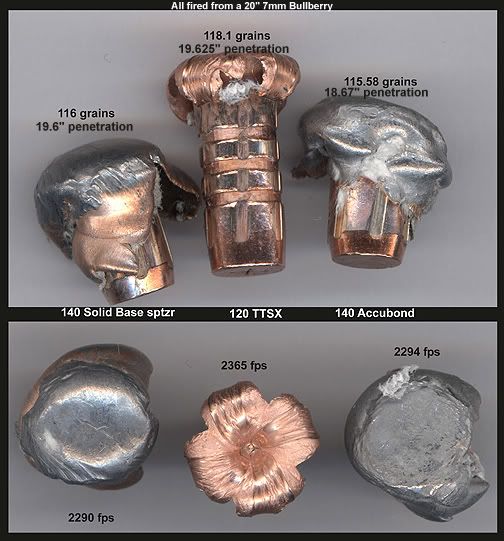 Bobby Μολὼν λαβέ The most important thing in life is not what we do but how and why we do it. - Nana Mouskouri | |||
|
| one of us |
Is Barnes changing its hype & marketing a bit? I just looked at their website, and I no longer saw the claim for "full depth of cavity expansion down to 1600 fps" with the TSX and TTSX. Maybe I just missed it as I skimmed through it fairly fast... Bobby Μολὼν λαβέ The most important thing in life is not what we do but how and why we do it. - Nana Mouskouri | |||
|
| one of us |
Rusty-Please keep us posted on your load work. I appreciate you posting it as I enjoy reading through it and seeing your results. Now if Nosler would just get an E-tip in 6.5 out there, you could give that one a run as well. Bobby Μολὼν λαβέ The most important thing in life is not what we do but how and why we do it. - Nana Mouskouri | |||
|
| One of Us |
Bobby, thanks for the test tips and the additional pictures. I read a thread recently where a shooter outside the US was using plastic shopping bags to hold soaked newspaper for his testing at 500 meters. He also had bullets veer off in wet news print. Some people are opening up the hollow point cavities in the TSX and X-Bullet tips by drilling them out and getting better low velocity expansion, which is something I am going to try eventually I believe. I am with you 100 percent on Nosler expanding their E-Tip offerings. Here, we are limited to bullets with no more than 1 percent lead used in the bullet alloy. Does anyone know if the E-Tip can meet that standard? | |||
|
| one of us |
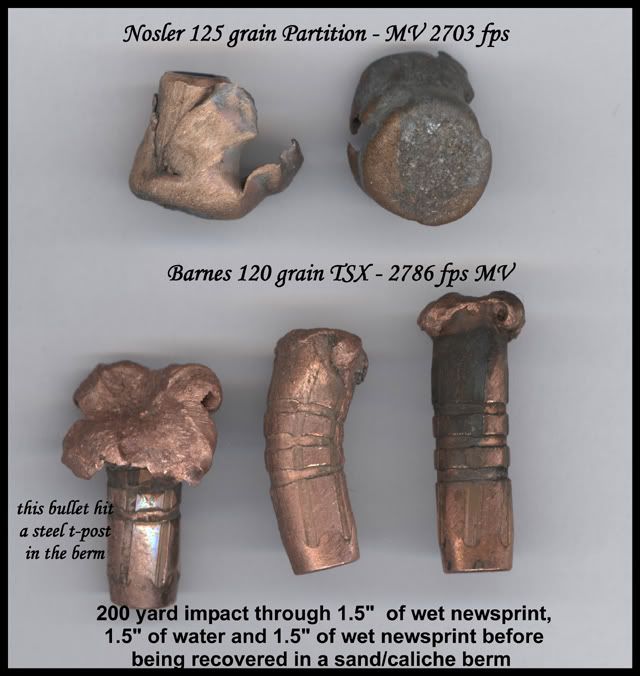 Rusty-The way I did this was a bit less scientific than I generally prefer, but I wanted to get this done this evening as your 6.5mm woes were on my mind. Anyway, I fired 3 Barnes 6.5mm 120 grain TSX bullets through 1.5" of wet newsprint, 1.5" of water and then 1.5" of wet newsprint again before recovering them in a sand/caliche berm. Even the hard impact of the berm did not do much for the TSX. Only one expanded significantly, and that is because it hit a steel t-post within the berm. The MV of these bullets was 2786 fps. I did not run the 200 yard velocity but will add that shortly (the impact was at 200 yards). As a "contol," I fired a couple of 125 grain, 6.5mm Partitions with a muzzle velocity of 2703 fps. THe results were exactly as I would expect with this type of hard impact. My results seem to mirror what you have been seeing. One of the bullets -- the one that's bent -- veered well off its course even before it exited the last of the newsprint. I had a hard time finding it, to be honest. As to the E-tip, I thought I heard it was approved for CA but could be wrong. I will see what I can find out for you. Bobby Bobby Μολὼν λαβέ The most important thing in life is not what we do but how and why we do it. - Nana Mouskouri | |||
|
| One of Us |
Bobby, Thanks again for your excellent input. Your results are very enlightening and sure disappointing for me. Just out of curiosity I tried drilling out the hollow point on a 120 gr, 6.5 TSX bullet this morning. The smallest drill bit I had was 1/16th of an inch in diameter. The hole is only about 1/8th of an inch deep in my TSX bullets, and I checked a number of them to make sure it was a consistent depth sample. I believe the hollow point holes are a good deal deeper in other caliber TSX bullets, at least the ones I have seen sectioned were a lot deeper than that, so I tried to drill it deeper but busted off the drill bit in the bullet I tried to drill. I really do not have the right equipment to do the job for that, and I believe this is a job that we hunters should not have to do for ourselves. I would need a drill press and a secured in place material clamp to hold the bullets to do the job properly. The chuck on my variable speed drill motor would not grip a bit that small, so I chucked-up the bullet in the drill motor and held the bit with a pair of Vise-grip Pliers. The resulting hole in the bullet is considerably larger in diameter than the original hollow point hole was and very slightly a little deeper where the bit broke off in the bullet. Of course I couldn't get the broken bit section out of the bullet but I may fire it anyway when I get enough newspaper built up to run a test. John Barsness does dry newspaper tests with his bullets and says it is comparable to shooting into heavy bone on large live animals. Most bullets that penetrate well will go about 12 to 14 inches in dry newspaper. He stacks it into appropriately sized cardboard boxes for testing, measuring the inches of penetration with a measuring tape and eyeballing the wound channels by separating the newspaper until he gets to what is left of the bullet. A number of bullets can be tested in one target box if you space your shots corectly, and boxes can be stacked one behind the other to be sure of trapping your bullets. The news paper, boxes and all, can go right in the recycle bin when you are done with your testing. Thanks again for all your hard work; it is much appreciated, at least by me...Rusty. Of course this is not going to give you any true on game indications of what the bullets you are testing are doing, but it is useful for comparing one bullet against another. The dry method is lighter to transport and a lot easier to handle and recycle than the wet method I would think. | |||
|
| one of us |
Rusty wrote:
I could not agree more! If Barnes would just admit that their bullets -- especially those under .30 caliber -- require significantly higher velocities for optimum results, that would be appreciated by those in the real world like you and me. But claiming full depth of cavity expansion down to 1600 fps is just plain ludicrous... Thanks for the tip on dry newsprint. I appreciate it. That certainly would be much easier -- not to mention LIGHTER -- to handle. I will give that a try soon. Bobby Μολὼν λαβέ The most important thing in life is not what we do but how and why we do it. - Nana Mouskouri | |||
|
| one of us |
Rusty- I did some checking for you, and California has approved the Nosler E-tip for use. Now you just need to convince Nosler we need some E-tips in 6.5mm.....like yesterday! Bobby Μολὼν λαβέ The most important thing in life is not what we do but how and why we do it. - Nana Mouskouri | |||
|
| One of Us |
Bobby, Thanks for the info. I checked Nosler's sight and they said that their E-Tips were 100 percent copper bullets, but jacket alloys are not 100 percent pure copper and the last information I had from the state was that Barnes X-Bullets were the only California approved bullets so far. That may have changed. GS Custom Bullets are also selling 100 percent pure copper bullets, they just wouldn't stabilize in my gun so I can't use them. The new regulations are due out as of July first, so we should have official clarification soon enough. I am with you, come on Nosler! Get it in gear with your 6.5 E-Tip Bullets. | |||
|
| One of Us |
Well I believe I have settled on a load for the 120 Gr. 6.5 TSX in my Encore - 49.0 grains of H4350 Extreme powder, lit with CCI 250 magnum primers. I tried the same load with CCI's BR primers but I got a little more velocity and more consistent velocity with the magnum primers. The velocity averaged 2,680 FPS, that is with one case showing a black ring around the primer and a velocity of only 2,666 FPS with that case. Velocity with the other two cases was 2,690 and 2,696 FPS. and a spread of .342 for both loads to the same point of impact at 10 feet. The BR primers produced 2,611, 2,656, 2,679 FPS respectively at 10 feet. I think 49.0 grains is a lot of H4350 powder to burn in a 13 inch barrel, so the magnum primers might burn the powder a little more effectively. The dry news print finally gave some bullet expansion out of the 120 grain TSXs. The low velocity load (1,800+ FPS) bullet that I had drilled out with a 1/16th drill bit shortened the bullet length about 1/8 th of an inch and opened to less than one caliber diameter. The 2,600+ FPS load shortened about 3/8ths of an inch and opened to .465 at the widest point but, I do not think I will be shooting many deer 10 feet from my muzzle with this or any other load, so I still have concerns about the Barnes TSX bullets expanding on deer out of my handgun at real life ranges. I will probably be trying to hit shoulder bone area to insure expansion if I get a shot at a deer. Penetration was about 10 inches into the dry news print with the low velocity load and 12 inches with the higher velocity load. My technique was to alternate the folded side of each section of the daily paper, placing each day's paper into brown paper bags until the bag was firmly filled. Then the bag was placed into a 8 and 1/2 X 11 paper case cardboard box. It took 5 brown bags of news print to fill the cardboard box. Just to be sure that I would capture my bullets, I placed one more bag of news print and 6 one gallon milk jugs filled with water behind the paper case, but it was not needed. The toughest part is the time it takes to accumulate enough news print to run a test. The paper wound channels were small enough that I believe you could test 5 different bullets on one box of paper...Rusty. | |||
|
| Powered by Social Strata |
| Please Wait. Your request is being processed... |
|
 The Accurate Reloading Forums
The Accurate Reloading Forums  THE ACCURATE RELOADING.COM FORUMS
THE ACCURATE RELOADING.COM FORUMS  Guns, Politics, Gunsmithing & Reloading
Guns, Politics, Gunsmithing & Reloading  Single Shot Pistols
Single Shot Pistols  7mm 120 grain TTSX recovered from a hog
7mm 120 grain TTSX recovered from a hog

Visit our on-line store for AR Memorabilia

